Abstract
In this paper, we present a city-scale (possibly global) air pollution network made of low-cost sensors for particulate matter concentration in the air. The components of the presented system are based on our research and experience from previous studies focused on air quality instruments and sensors for addressing urban air pollution. Sensor nodes are produced locally and distributed over Sarajevo, Bosnia and Herzegovina. The system collects, calibrates, and displays particulate matter concentrations in real-time. In comparison to the available measurements from governmental institutions, our system demonstrated good agreement of measured parameters, with several advantages including, higher resolution in space and time, lower costs, both horizontal and vertical measurements. One of the capabilities of the system is the real-time air pollution city map with animations. By installing multiple sensor nodes over a slope, we receive vertical measurements of temperature, humidity, and particulate matter concentration in real time, which gives a valuable insight into the dynamics of temperature inversion episodes and air pollution below the inversion layer.
1. Introduction
The city of Sarajevo, capital of Bosnia and Herzegovina, is heavily affected with air pollution with one primary component of pollution: particulate matter (PM). All other components of air pollution, for example, heavy metals [1], are mostly within the safe exposure level. According to the report of the World Bank [2], it is estimated that 3300 premature deaths per year can be related to the air pollution in Bosnia and Herzegovina, while the economic costs are between 1 and 1.8 billion US dollars.
In order to illustrate typical exposure levels of the concentration of particulate matter smaller than 2.5 m in diameter (), we present Table 1 with statistics for the last 5 years (this was measured using the system presented in this article). One of the reasons for a such strong air pollution is the topology of the terrain. With an average altitude above sea level (ASL) of 550 m, Sarajevo is situated in a valley surrounded by mountains, and it is affected by temperature inversions during the winter time. Our previous research on using drones for investigation of temperature inversion [3] shows that the temperature gradient in the inversion layer is very strong and the height at which temperature inversion appears is low, often just 100 m to 150 m above the ground. This prevents natural convection and pollutants emitted by households, traffic and other sources are accumulated below the inversion layer. Figure 1 shows the drone image of central part of Sarajevo, taken during a research mission.

Table 1.
Yearly statistics for concentration of (in g/m3) at the location of Faculty of Mechanical Engineering in Sarajevo.
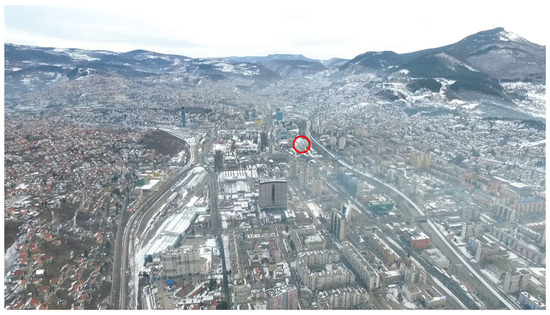
Figure 1.
Central part of Sarajevo and surrounding mountains. Image taken from drone on 31 January 2022. Faculty of Mechanical Engineering is indicated with red circle.
Our system occasionally detected daily average values of concentrations greater than 500 g/m3, which is alarming according to the local regulation. In order to address this issue, we need measurements not only of air pollutants concentrations but also those related to the temperature inversion phenomenon (vertical profiles of temperature across the inversion layer). Then, we can quantitatively describe the influence of temperature inversion on the air pollution in the city.
Governmental institutions have a sparse network of stations for monitoring several components of air pollution. The spatial and temporal resolution of such measurements is low, and there is no information about vertical distribution of pollutants and temperature. Our system which is named MAQS (Mobile Air Quality System) is designed to provide high resolution measurements of air pollution components and meteorological parameters, with both horizontal and vertical variations of sensor locations.
2. About MAQS
MAQS is a system for collecting, storing and displaying measurements of air pollution and meteorological parameters in real time. It is based on internet cloud, as shown in Figure 2. The software components of MAQS are designed using open source projects. The code for server, which is responsible for direct communication with sensors, is developed in-house and written from scratch in C++ programming language with significant use of the Boost library [4]. It is highly optimized code designed to be flexible and scalable. Our approach is based on multi-threaded asynchronous server code with parallelized database connections. The database load balancing is implemented using the round-robin (RR) algorithm. In that case, we can have a large number of concurrent connections (active sensors) using very moderate computer resources. In order to test the scalability of MAQS server code, a simulator was created to test the performance of the MAQS server under the concurrent activity of many thousands of sensors, and the results were outstanding: with 10,000 simulated sensors, our server had CPU load of around 23% using only two cores (out of 16) on Intel Xeon E5-2620 v4 processor and produced 1.43 Mbit/s of network traffic on average. The MAQS server is so efficient that it can run on a Raspberry Pi 3 single board computer (with very limited hardware resources). In reality, the MAQS server uses the Ubuntu Linux operating system installed on a mid-range desktop PC (Intel Core i5-4460 with 6 GB of DDR3 RAM). The measurements are stored in a database. We use open source relational database PostgreSQL [5]. Clients with appropriate permissions can access the database using SQL queries.

Figure 2.
Components of MAQS: sensors, server with database, and clients connected via internet cloud.
MAQS sensors represent the most important component of the system. We have developed two generations of sensors:
- Generation 1—each sensor from this generation is powered by an Arduino [6] microcontroller (Mega or Due) with external ESP8266 Wi-Fi network chip.
- Generation 2—this generation omits Arduino and uses ESP32 for both network and processing tasks [7].
Any combination of sensors from first and second generation is supported by our server (both generations are still in use, but Generation 1 is being phased out gradually). Communication between sensors and the server is implemented using our own protocol and TCP/IP connection. This choice is crucial to achieve the reliability and robustness of the system. In reality, Wi-Fi connections are unstable (particularly at some of our locations of measurements) and we cannot afford to lose data because of that. TCP has mechanism of retransmission: if data packet is damaged or lost, it will be resent.
The MAQS protocol defines messages with a header (of fixed size) and payload of variable size, which contains the measurements. It is protected with a cyclic redundancy check (CRC-16) error-detecting code. There are four types of control messages: new measurement, transfer the oldest measurement, delete the oldest measurement, and keep alive message. Measurements are stored locally in RAM or flash memory of the sensor until they are transferred to the server. If the connection is interrupted for too long, once the local buffer is full, the oldest measurement is overwritten.
At the beginning, there was a batch of 10 sensors, while at the time the manuscript is written, there are 17 outdoor sensors. We have a list of desired locations with priorities given to the settlements with a significant population and absence of any nearby monitoring device or to the locations for observing important natural phenomena (temperature inversion and microclimate characteristics). Then, we have the list of available locations, where we can install the sensors. Using these two lists, we install the sensors starting from the most desired and available locations. Most MAQS sensors are installed at public institution like schools, faculties, and cable car, but also at private objects like houses and small family companies.
2.1. Particulate Matter Sensor
The choice of particulate matter sensor for the MAQS project was the most important decision. We previously evaluated PM sensors for mobile measurements [8] and found suitable sensor for this project: PMS5003 (Plantower, Nanchang, China). Apart from being the low-cost sensor, PMS5003 demonstrated surprisingly good correlations with reference measurements of under conditions of strong urban pollution in Bosnia and Herzegovina, which is illustrated in Figure 3. In order to verify performance of PMS5003 sensor, we organized campaign from 2 December 2019 until 2 March 2020 with reference (gravimetric) measurements of concentrations. Sampling was performed with a Gemini sampler (Dadolab, Milan, Italy) with an air flow rate of 2.3 m3/h. The sampling started at 12:00 (local time, CET zone) each day and ended at 11:58 the next day. Two minutes were reserved for an automatic filter exchange. Particles were collected on quartz filters with a diameter of 47 mm. The filters were carried out through a stabilization and weighing procedures strictly according to the requirements of the standard EN 12341:2014. In this campaign, PMS5003 produced coefficient of determination with reference measurements (for daily average concentrations of ) and performed better than more expensive OPC-N2 (Alphasense, London, UK) sensor [8]. The absolute values are overpredicted by PMS5003, mostly due to the effect of the hygroscopic growth of aerosols as we explained in detail [8]. However, this behavior is suitable for corrections, especially if take into account good linearity of the sensor and no observable time drift in the long-term use [8].
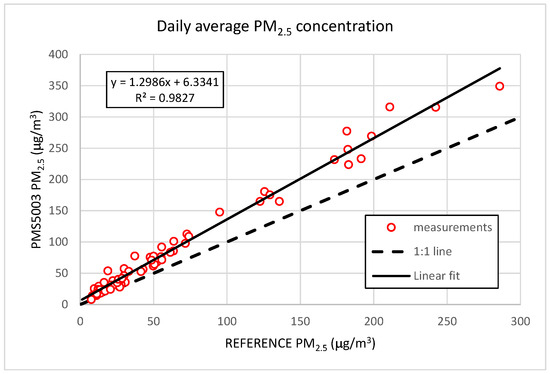
Figure 3.
Evaluation of PMS5003 sensor: reference gravimetric measurements.
PMS5003 is one of the most analyzed particulate matter sensors. Numerous studies are dedicated to laboratory and field tests of PMS5003. It was tested in [9] using laboratory and field tests where a high bias of PurpleAir (PMS5003) was observed. In [10], PurpleAir (PMS5003) was analysed for 16 months in Charlotte, North Carolina, USA, against BAM-1022, and a high bias of PurpleAir (PMS5003) that increases with humidity was reported. A high mean bias of (PMS5003) was reported in [11] as well.
The PMS5003 sensor uses Mie scattering theory to determine PM concentrations. This theory provides the solution of the Maxwell equations for the scattering of plane waves on spherical particles [12]. Laboratory tests of [13,14] are particularly important for understanding the limitations of PMS5003. According to these tests, two major limitations of PMS5003 are as follows:
- It cannot detect properly coarse particles (especially those larger than 2.5 m) because most particles miss the focal point of laser beam. When this happens for large particle, it is incorrectly sized.
- Strong wind can obstruct sensor’s aspiration, depending on the wind direction relative to the sensor inlet.
The reason why PMS5003 works so well in Sarajevo, when urban pollution is strong, is that none of these two conditions apply: during temperature inversion periods, there is no wind under the inversion layer, and mass spectrometry of the particles shows that contribution of coarse particles is very small. In our campaign [8], we simultaneously measured and concentrations using reference gravimetric method, from 2 December 2019 until 12 March 2020, and calculated that makes 87% of mass. These are favorable conditions for the Plantower sensor. However, when the spectrum of PM contained a large number of coarse particles, such as the Aralkum desert sand observed in Sarajevo on 27 March 2020, the PMS5003 performed poorly (Alphasense OPC-N2 was much better in this scenario) [8]. However, these desert sand episodes are not frequent in Sarajevo, while the pollution from combustion dominates most of the time, so the overall conclusion is that PMS5003 is indeed the optimal sensor for this project.
2.2. Quality Control and Calibration of Sensors
We acquire sensors in batches, usually of 10 sensors at a time. There are three steps of the quality control and calibration procedure. The first step is to compare sensors for uniformity. All sensors should show the same trends, but there is a slight difference in their readings (acknowledged by the manufacturer in data sheet). Every batch of sensors is tested in our laboratory for 24 h under controlled conditions (Figure 4). The sensors that deviate in readings more than 8% from the average value of the batch are discarded. Then, we proceed to the second step: outdoor tests at the Faculty (Figure 5). Sensors are tested against the research-grade instrument Grimm 11-D (Durag, Hamburg, Germany). The duration of this phase is 7 days. An initial set of calibration coefficients is determined for each sensor in this step. Finally, sensors are tested against the reference gravimetric method, using a dual air sampler, with and inlets, for an additional 10 days. The sampling period in the third phase is 24 h. Calibration coefficients are adjusted for the final deployment. One sensor from each batch stays in the laboratory for long-term observations, while remaining sensors are deployed to their final locations. The reference gravimetric method is most accurate, but it is a stationary system with long sampling periods (24 h). However, Grimm 11-D is a portable instrument, which can run on battery for 10 h with time resolution of 6 s, and it is used to verify readings at any location. In these three steps, we eliminate any erroneous sensors from the MAQS network.
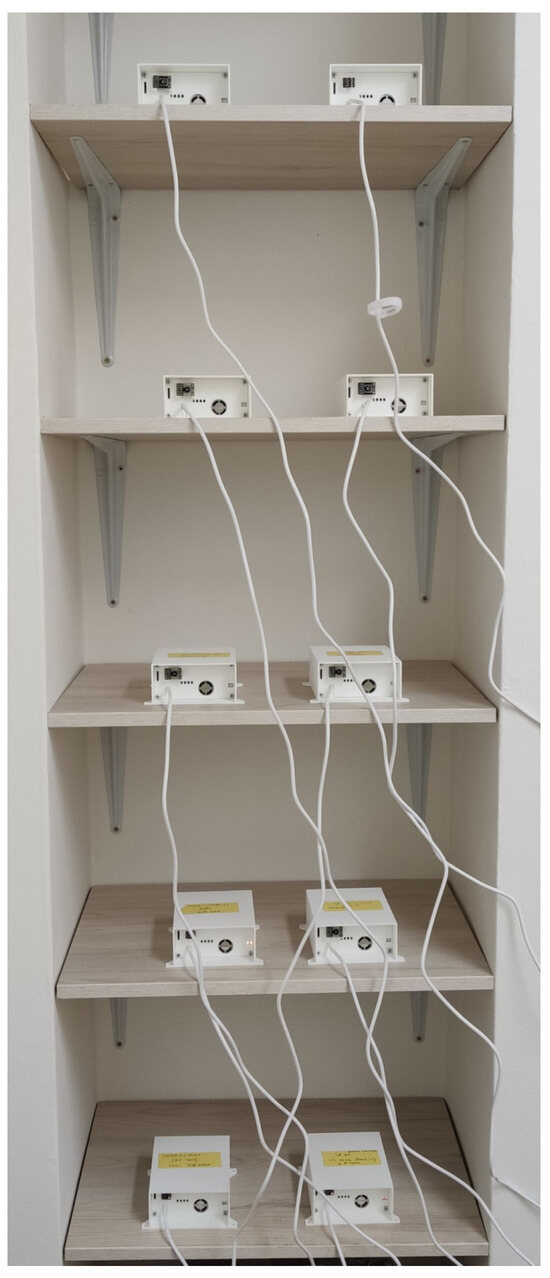
Figure 4.
Calibration of MAQS sensors: batch of 10 sensors that are being calibrated in our laboratory for particulate matter spectroscopy and gravimetry.
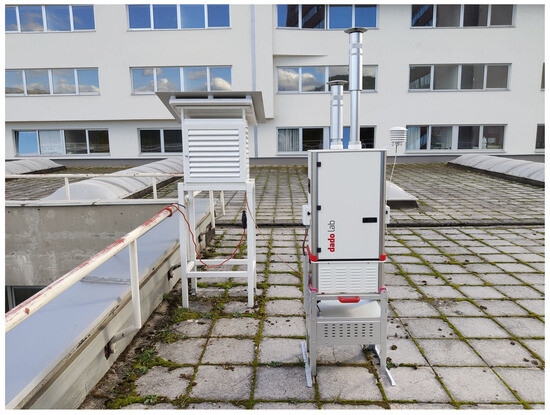
Figure 5.
Dual air sampler and Stevenson screen with MAQS sensors inside.
As we have explained in [8], we propose the correction of raw readings from the sensor using steady (seasonal) calibration coefficients, determined for each sensor individually. These corrections can be linear for concentrations of up to 300 g/m3. Above 300 g/m3 (which is rare situation even in Sarajevo), we observed non-linear effects, so the quadratic corrections fit better. In general, real-time corrections in the MAQS system use the second-order equation , with coefficients A, B and C determined in step 3 of the above-mentioned procedure. These coefficients are steady within a season (winter, summer spring, and autumn) but not permanent during the lifetime of a sensor. We do not recommend calibrations using floating correction coefficients (for example, based on instantaneous value of ambient air humidity), because such a procedure inserts noise into results since the effective hygroscopic growth coefficient depends on the composition of particles. Furthermore, the internal structure of the sensor and self-heating effect represent additional uncertainties in such an approach [8]. It is known that PMS5003 readings show dependence on relative humidity but less than predicted by simple hygroscopic growth theory [15].
It would be useful to test enclosures with some kind of humidity regulation, which is our future task. We already demonstrated the effectiveness of an in-house developed diffusion dryer, but it was applied to a different class of instrument—portable aerosol spectrometer Grimm 11-D (Durag, Hamburg, Germany) [8]. Promising results of the development of dryers for low-cost sensors were reported in [16,17].
In the MAQS system, calibration is implemented at the database level. When a new measurement arrives, it is stored in the main table (without corrections). At the same time, the calibration trigger calls a special function which corrects the measurement based on the parameters from the calibration table. Corrections with three parameters (linear and quadratic polynomial) are supported in real time (apparently any correction can be applied in post processing). The corrected value is calculated and saved in the appropriate table. Hourly and daily averages are also recalculated. In this way, users have calibrated measurements in real time.
Each MAQS sensor has PMS5003 inside, while other sensors are optional. Table 2 shows physical quantities which have been measured using the MAQS system. Enclosures for MAQS sensors are designed and produced in-house. The basic enclosure is produced using a 3D printer (Figure 4), while advanced enclosure requires machining as well. Measurements of optional quantities can be calibrated the same way as PM concentrations (they have their own entries in the MAQS calibration table).

Table 2.
Supported external sensors.
Every MAQS sensor measures time (using GNSS receiver or Internet time servers), , , , and 6 size bins from PMS5003 sensor as frequent as possible (once per second), and results are averaged over a period of 60 s and then stored in the database. The same averaging technique applies if there are optional sensors from Table 2.
2.3. Comparison with Governmental Monitor
We have installed an MAQS sensor on the University building (Faculty of Electrical Engineering) in the immediate vicinity of the US Embassy in Sarajevo, which hosts an air quality station with a beta attenuation monitor BAM-1020 (MetOne, Grants Pass, OR, USA). Long-term observations from 21 February 2019 to 4 May 2020 (438 days) are summarized in Figure 6. The MAQS sensor performed well in the long run, with coefficients 0.919, 0.980, and 0.998 for hourly, daily, and monthly average value, respectively.
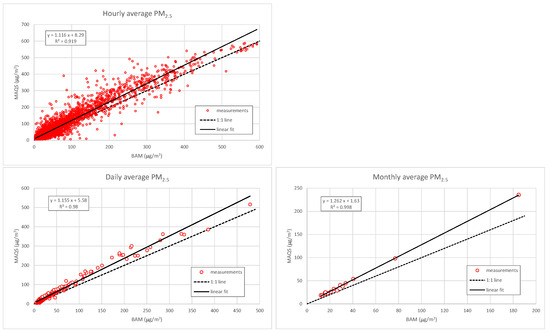
Figure 6.
Long-term comparison of MAQS and US EPA station with BAM-1020.
2.4. Limitations of MAQS
MAQS is based on low-cost sensors, and it inherits both advantages and disadvantages of such technology. The PMS5003 sensor performed better than expected during the period of strong urban pollution caused by burning of fossil fuels and biomass. However, observations in spring when the pollution was mild and caused by various components, including the transported dust from afar, significantly decreased the coefficient of determination when MAQS was compared with reference instruments (gravimetric).
Figure 7 shows measurements of and concentrations from 13 March 2020 to 4 May 2020. In comparison with the reference gravimetric instrument, the MAQS sensor produced coefficients of 0.730 and 0.718 for and , respectively.

Figure 7.
The MAQS sensor evaluation during the mild air pollution period from 13 March 2020 to 4 May 2020.
Research-grade mass spectrometer Grimm 11-D registered atypical particle distribution on 27 March 2020. It was Aralkum desert dust transported from afar, where coarse particles dominate in the spectrum, as Figure 8 shows. The PMS5003 sensor inside the MAQS node was not able to detect coarse particles due to reasons explained in [14]. Under such particle distribution, the MAQS sensor cannot determine the fraction accurately (Figure 8).
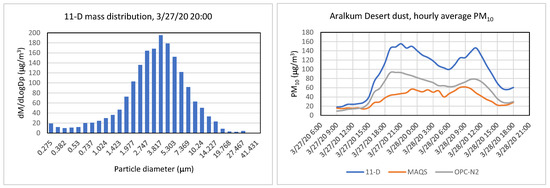
Figure 8.
Atypical particle composition: Aralkum desert dust. Comparison of Grimm 11-D, MAQS, and Alphasense OPC-N2 readings.
2.5. Related Works
MAQS is not the only project of this type. For example, the PurpleAir network is often discussed [18]. It is a similar project which employs two Plantower PMS5003 sensors in nodes, which are connected to the Internet cloud (ThingSpeak) using Wi-Fi. PurpleAir is tested against governmental and research stations in USA [15,19] and Greece [11,20]. They reported reasonable correlations in various comparisons with reference or equivalent stations with values in the range from 0.56 to 0.98 and high bias of the sensor which was corrected using the multilinear regression.
Mobile sensor nodes called ExpoLIS were developed in Portugal [21]. Sensor nodes were installed in buses to map air quality corridors across the city. Particulate matter sensor was OPC-N3 (Alphasense, London, UK). Reported results from the comparison between the OPC-N3 and beta attenuation monitor MP101M (Envea, Poissy, France) were not satisfactory: coefficient was 0.04 for and 0.12 for . After they applied corrections (multilinear regression based on Kohler theory), coefficient increased to 0.17 for and 0.47 for .
Another project for sensor nodes called AIRBOX was implemented in Italy [22]. They measured several parameters including using the PPD20V sensor (Shinyei, Kobe, Japan). In comparison with the monitoring station of the local environmental agency, they reported a coefficient of correlation R (not ) in the range from 0.80 to 0.95.
Taking into account above-mentioned projects, we can say that MAQS is a unique long-term project with its own cloud server, vertical measurements for temperature inversion research, live pollution map (based on modified IDW algorithm), and non-linear real-time corrections.
3. Results and Discussion
The first batch of 10 MAQS sensors was installed in the year 2018 across Sarajevo Canton. In cooperation with our partners, the second batch of sensors was distributed over several locations in Bosnia and Herzegovina (outside of Sarajevo Canton) and three locations abroad. Currently, we are focused on Sarajevo, but MAQS is a global system already and supports world-wide locations. We will give three examples in the following subsections.
3.1. World-Wide Locations
Prior to the coronavirus pandemic, MAQS sensors were installed in Calgary (Canada), Zurich (Switzerland), and Akure (Nigeria). Figure 9 shows measurements in Zurich from 30 December 2018 to 1 February 2019. We can see strong air pollution, with variable intensity (depending on local meteorological conditions).
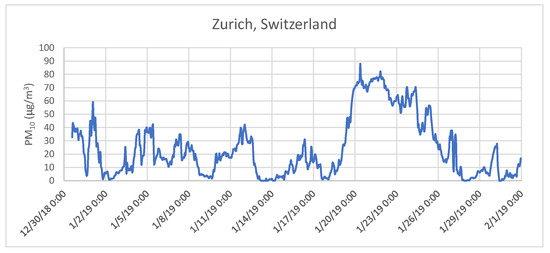
Figure 9.
Hourly average values of concentration in Zurich from 30 December 2018 to 1 February 2019.
A very interesting situation was observed in Calgary, as Figure 10 shows. The Canadian province Alberta was affected by wildfires, particularly on 31 May 2019. The MAQS sensor in Calgary detected very high concentrations on that day.
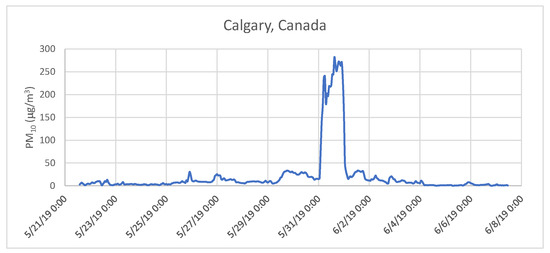
Figure 10.
Hourly average values of concentration in Calgary from 21 May 2019 to 7 June 2019.
3.2. Pollution Map
In order to generate the pollution map, we need to estimate air pollution in every single point of the city. With limited number of sensors, we have to use a certain interpolation algorithm for that purpose. Inverse distance weighting (IDW) is commonly used in geosciences for such interpolations. We have adopted IDW here with some modifications. If we have N sensors accros the city, they give values of desired parameter at the location of each sensor. The value of at some arbitrary point M is estimated using the formula
where is the distance from sensor i to the point M, and p is the power parameter. The choice of power parameter is not trivial. For a small power parameter, such as , interpolated values may be dominated by points that are far away. When p is large, the generated map looks like a mosaic of tiles with a nearly constant interpolated value. Our choice for the live pollution map is . An additional modification was implemented: only nearest neighbors within sphere of radius R were taken into account for interpolation. This is combined with our spatial search algorithm for efficient implementation, which makes the map viewable on mobile devices with limited processing speed.
The live pollution map is presented on web page https://www.maqs.info (accessed on 30 April 2024) using OpenLayers library [23]. Figure 11 shows the screenshot of the live map from 9 December 2019, where we can see interesting spatial variation in the concentration. Mild eastern wind cleared air pollution from the eastern part of Sarajevo, but it was not strong enough to reach the western part of the city (this scenario was detected several times using the MAQS live pollution map). Tall buildings (visible in Figure 1) are obstructing ventilation of the city in the case of mild wind. This shows that MAQS can be used as a tool in urban planning, microclimate studies, and future low-emission zones establishment.
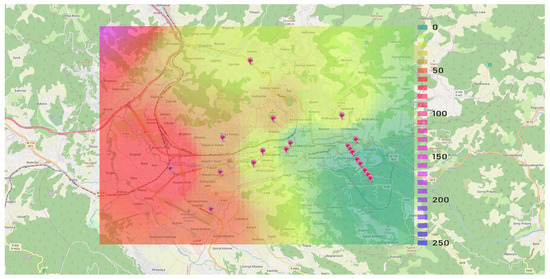
Figure 11.
Live pollution map for 9 December 2019: example of spatial variation of concentration across the city. Markers on the map are sensor locations.
When the mouse cursors hovers over the map (or the screen is briefly touched on a mobile device), the interpolated value in that point will be displayed as shown in Figure 12.

Figure 12.
Live pollution map for 28 April 2024: mouse hovering for display of AQI category (calculated using only) and concentration in every point on the map.
The map can be animated in two ways: by pressing the ‘H’ button for hourly animations over the last 24 h or by pressing the ‘D’ button for daily animations for the last 10 days.
3.3. Vertical Profiles and Temperature Inversion
Figure 13 shows hazardous air pollution in Sarajevo on 6 December 2019. Temperature inversion was strong and stable which resulted in accumulation of pollutants. Only peripheral parts of the City with altitudes greater than 800 m ASL were above the inversion lid.
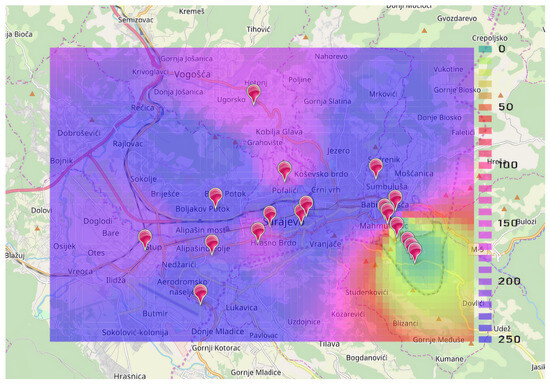
Figure 13.
Live pollution map for 6 December 2019: City of Sarajevo under hazardous air pollution.
In order to test the capabilities of the MAQS system to measure vertical profiles, a special campaign was organized during the first 3 weeks of the year 2020, when strong temperature inversion had been expected. We performed several preliminary measurements using drones [3] and concluded that the location of the Sarajevo cable car (which spans from nearby the City Hall to Trebevic mountain, with length of 2.1 km and height difference of 580 m) would be suitable for measurements. In cooperation with the City of Sarajevo, who is the owner of the cable car, we have installed a batch of eight MAQS sensors on the pillars of the cable car, as shown in Figure 14. Each sensor is mounted on top of a pillar, while precise altitude of the sensor is determined using GNSS measurements and listed in Table 3.
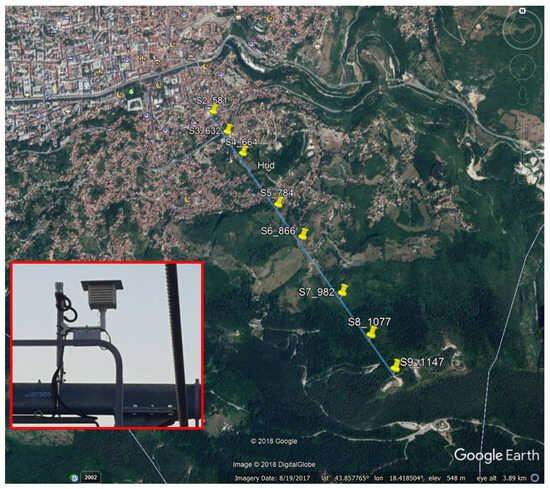
Figure 14.
Sarajevo cable car pillars (yellow markers) and terrain from Google Earth. A MAQS sensor is shown in red box.

Table 3.
Vertical positions of sensors on cable car pillars.
MAQS sensors for this campaign were equipped with SHT31-D temperature and humidity sensors (Sensirion, Stäfa, Switzerland) together with mandatory PMS5003 PM sensors (and above-mentioned GNSS receivers). Each SHT31-D sensor was calibrated in our laboratory prior to deployment. There was no Wi-Fi connection over the cable car route, so we had to use our own GSM modems and Wi-Fi repeaters in very challenging conditions. SD cards were installed in each MAQS sensor to prevent data loss in case of Internet connection problems. During this campaign, the data availability was 100% (not a single measurement was lost) which shows the reliability of the MAQS system.
The anticipated temperature inversion in this period appeared to be very strong and stable, which made this campaign successful. Figure 15 shows six characteristic profiles of temperature and . When there is no temperature inversion (6 January 2020 5:00), concentrations were low and well distributed over the city (vertically in the range of measured altitudes). This plot shows a linear decrease in temperature with altitude. Despite low ambient temperatures (well below zero degrees Celsius), wind and natural convection prevented accumulation of pollutants which resulted in excellent air quality at that time.
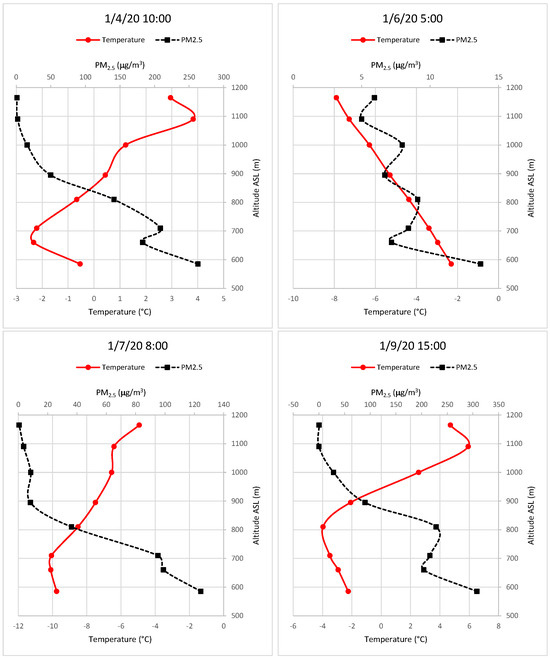
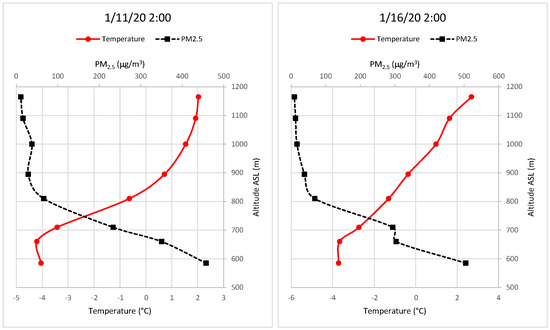
Figure 15.
Temperature inversion profiles.
However, different situation happened two days earlier (4 January 2020 10:00), when temperature profile had characteristic “Z” shape. That morning inversion layer started about 100 m above ground level (AGL) and ended about 500 m AGL, with gradient in the inversion layer of 15.5 K/km. The concentration of below the inversion layer reached 250 g/m3. Similar profile was recorded on 9 January 2020 15:00, with a difference often observed in the afternoon: the inversion layer started higher, at about 250 m AGL. The gradient in the inversion layer was even greater, 33.3 K/km, which in combination with cold air in the city resulted in hazardous air pollution with exceeding 300 g/m3.
Plot from 7 January 2020 8:00 shows the inversion layer starting from 150 m AGL all the way to top of the mountain, but with a lower gradient of 10.8 K/km. The air temperature in the city of Sarajevo was −10 °C, while the concentration was 120 g/m3.
The last two graphs (11 January 2020 2:00 and 16 January 2020 2:00) show similar effects: the inversion layer starting from 150 m AGL with gradients around 13 K/km. Stable and lasting inversion trapped pollutants for longer periods of time, which resulted in concentrations of 500 g/m3 even at 2 a.m., when most human activities were suspended.
The relative humidity is also stratified along the inversion layer. Figure 16 shows two relative humidity profiles for the morning of 4 January 2020 and afternoon of 9 January 2020. Below the inversion layer (inside the City), the relative humidity was very high (around 90%), while on Trebevic mountain (above inversion layer), it was around 40%.
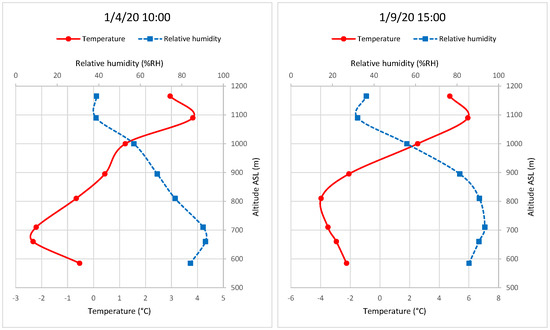
Figure 16.
Relative humidity profiles.
4. Conclusions
A new system called MAQS for high resolution spatial and temporal monitoring of air pollution in urban environments has been developed and employed. After comprehensive evaluation, which included laboratory and field tests, an optimal particulate matter sensor was chosen—Plantower PMS5003. The system is mostly developed in-house, while several components are being imported: particulate matter sensor, wireless network adapter and optional external sensors. Advanced code for server, and sensors is written from scratch. An efficient calibration procedure is established and verified.
This system proved its capabilities to augment a sparse governmental network of monitoring stations. It offers high-resolution measurements in space and time, with the ability to generate a live pollution map. Furthermore, it is used to measure vertical profiles of temperature, humidity and particulate matter concentration, which is very important for understanding qualitative and quantitative characteristics of temperature inversion. Using MAQS, we have quantitatively shown that two major parameters of temperature inversion, in the context of air pollution, are height above the ground where the inversion layer starts and temperature gradient in the inversion layer. Unfortunately, both of these parameters are unfavorable in Sarajevo, resulting in extreme episodes of air pollution.
We have collected more than 60 million database records so far. This database is a very valuable asset for the research of air pollution. MAQS can be used in future microclimate studies, urban planning projects, and low-emission zones.
MAQS inherits some limitations from low-cost sensors. It cannot properly measure coarse particles, and if they dominate in the spectrum, measurements of will be inaccurate, as we can see from the Aralkum desert dust example. Furthermore, the current number of installed sensors is relatively small, which leaves some parts of the pollution map far from any sensor.
We plan to increase the number of sensors in the near future, so that we can detect hyperlocal sources of particulate matter emissions and increase the resolution of the live pollution map. In the meantime, we will consider some numerical models for estimating the particulate matter distribution over the area where an observation is missing.
Sensor modifications to include air dryers to prevent high bias of the sensors due to hygroscopic growth of aerosols will be tested in the future.
Funding
This research received no external funding.
Institutional Review Board Statement
Not applicable.
Informed Consent Statement
Not applicable.
Data Availability Statement
Live data are available at https://www.maqs.info (accessed on 30 April 2024). Access to the database with all stored measurements is possible upon request.
Acknowledgments
This work is dedicated in honor of my colleague Boran Pikula. Furthermore, I would like to thank Damir Muslic who contributed the code for the MAQS. I also appreciate the endless discussions with Dzevad Bibic about this project. Assistant Faruk Razic provided several locations for sensor nodes and personally installed several sensors, which is greatly appreciated. Last but not least, I would like to thank Sarajevo Cable Car Company and Adnan Selmanovic for their extraordinary cooperation.
Conflicts of Interest
The author declares no conflicts of interest.
Abbreviations
The following abbreviations are used in this manuscript:
| AQI | Air Quality Index |
| AGL | Above Ground Level |
| ASL | Above Sea Level |
| GNSS | Global Navigation Satellite System |
| IDW | Inverse Distance Weighting |
| MAQS | Mobile Air Quality System |
| PM | Particulate Matter |
| SQL | Structured Query Language |
| TCP/IP | Transmission Control Protocol/Internet Protocol |
References
- Trako, N.; Masic, F.; Ajanovic, F.; Merdan, S.; Huremovic, J.; Zero, S.; Masic, A.; Gojak-Salimovic, S. Health risk assessment of heavy metals in PM2.5 and PM10 in Sarajevo air, Bosnia and Herzegovina. J. Environ. Sci. Heal. Part 2024, 58, 1039–1045. [Google Scholar] [CrossRef] [PubMed]
- Awe, Y.A.; Murisic, M.; Kreso Beslagic, E.; Rinnerberger, N.; Oguz Kuntasal, O.; Brody, M.S.; Golub, E.S.; Enriquez, S.; Paranos, D.; Colovic-Daul, M. Air Quality Management in Bosnia and Herzegovina (English); World Bank Group: Washington, DC, USA, 2019; Available online: https://documents.worldbank.org/curated/en/117281576515111584/Air-Quality-Management-in-Bosnia-and-Herzegovina (accessed on 30 April 2024).
- Masic, A.; Bibic, D.; Pikula, B.; Dzaferovic-Masic, E.; Musemic, R. Experimental study of temperature inversions above urban area using unmanned aerial vehicle. Therm. Sci. 2019, 23, 3327–3338. [Google Scholar] [CrossRef]
- Boost C++ Libraries. Available online: https://www.boost.org/ (accessed on 30 April 2024).
- PostgreSQL: The World’s Most Advanced Open Source Relational Database. Available online: https://www.postgresql.org/ (accessed on 30 April 2024).
- Arduino. Available online: https://www.arduino.cc/ (accessed on 30 April 2024).
- ESP-IDF. Available online: https://idf.espressif.com/ (accessed on 30 April 2024).
- Masic, A.; Bibic, D.; Pikula, B.; Blazevic, A.; Huremovic, J.; Zero, S. Evaluation of optical particulate matter sensors under realistic conditions of strong and mild urban pollution. Atmos. Meas. Tech. 2020, 13, 6427–6443. [Google Scholar] [CrossRef]
- Tryner, J.; L’Orange, C.; Mehaffy, J.; Miller-Lionberg, D.; Hofstetter, J.C.; Wilson, A.; Volckens, J. Laboratory evaluation of low-cost PurpleAir PM monitors and in-field correction using collocated portable filter samplers. Atmos. Environ. 2020, 220, 117067. [Google Scholar] [CrossRef]
- Magi, B.I.; Cupini, C.; Francis, J.; Green, M.; Hauser, C. Evaluation of PM2.5 measured in an urban setting using a low-cost optical particle counter and a Federal Equivalent Method Beta Attenuation Monitor. Aerosol Sci. Technol. 2020, 54, 147–159. [Google Scholar] [CrossRef]
- Kosmopoulos, G.; Salamalikis, V.; Pandis, S.N.; Yannopoulos, P.; Bloutsos, A.A.; Kazantzidis, A. Low-cost sensors for measuring airborne particulate matter: Field evaluation and calibration at a South-Eastern European site. Sci. Total Environ. 2020, 748, 141396. [Google Scholar] [CrossRef] [PubMed]
- Mie, G. Beitrage zur Optik truber Medien, speziell kolloidaler Metallosungen (contributions to the optics of diffuse media, especially colloid metal solutions. Ann. Phys. 1908, 25, 377–445. [Google Scholar] [CrossRef]
- Kuula, J.; Makela, T.; Aurela, M.; Teinila, K.; Varjonen, S.; Gonzalez, O.; Timonen, H. Laboratory evaluation of particle-size selectivity of optical low-cost particulate matter sensors. Atmos. Meas. Tech. 2020, 13, 2413–2423. [Google Scholar] [CrossRef]
- Ouimette, J.; Arnott, W.P.; Laven, P.; Whitwell, R.; Radhakrishnan, N.; Dhaniyala, S.; Sandink, M.; Tryner, J. Fundamentals of low-cost aerosol sensor design and operation. Aerosol Sci. Technol. 2024, 58, 1–15. [Google Scholar] [CrossRef]
- Barkjohn, K.K.; Gantt, B.; Clements, A.L. Development and application of a United States-wide correction for PM2.5 data collected with the PurpleAir sensor. Atmos. Meas. Tech. 2021, 14, 4617–4637. [Google Scholar] [CrossRef] [PubMed]
- Chacon-Mateos, M.; Laquai, B.; Vogt, U.; Stubenrauch, C. Evaluation of a low-cost dryer for a low-cost optical particle counter. Atmos. Meas. Tech. 2022, 15, 7395–7410. [Google Scholar] [CrossRef]
- Nothhelfer, M.; Sperber, O.; Todea, A.M.; Schunke, B.; Romazanowa, O.; Schumacher, S.; Bathen, D.; Asbach, C. Effect of an Aerosol Dryer on Ambient PM Measurements with SDS011 Low Cost Sensors during a Two-year Period in Duisburg, Germany. Aerosol Air Qual. Res. 2023, 23, 230080. [Google Scholar] [CrossRef]
- Couzo, E.; Valencia, A.; Gittis, P. Evaluation and Correction of PurpleAir Temperature and Relative Humidity Measurements. Atmosphere 2024, 15, 415. [Google Scholar] [CrossRef]
- Barkjohn, K.K.; Holder, A.L.; Frederick, S.G.; Clements, A.L. Correction and Accuracy of PurpleAir PM2.5 Measurements for Extreme Wildfire Smoke. Sensors 2022, 22, 9669. [Google Scholar] [CrossRef] [PubMed]
- Stavroulas, I.; Grivas, G.; Michalopoulos, P.; Liakakou, E.; Bougiatioti, A.; Kalkavouras, P.; Fameli, K.M.; Hatzianastassiou, N.; Mihalopoulos, N.; Gerasopoulos, E. Field Evaluation of Low-Cost PM Sensors (Purple Air PA-II) Under Variable Urban Air Quality Conditions, in Greece. Atmosphere 2020, 11, 926. [Google Scholar] [CrossRef]
- Correia, C.; Martins, V.; Matroca, B.; Santana, P.; Mariano, P.; Almeida, A.; Almeida, S.M. A Low-Cost Sensor System Installed in Buses to Monitor Air Quality in Cities. Int. J. Environ. Res. Public Health 2023, 20, 4073. [Google Scholar] [CrossRef] [PubMed]
- Penza, M.; Pfister, V.; Suriano, D.; Dipinto, S.; Prato, M.; Cassano, G. Application of Low-Cost Sensors in Stationary and Mobile Nodes for Urban Air Quality Index Monitoring. Eng. Proc. 2023, 48, 62. [Google Scholar] [CrossRef]
- OpenLayers Library. Available online: https://openlayers.org/ (accessed on 30 April 2024).
Disclaimer/Publisher’s Note: The statements, opinions and data contained in all publications are solely those of the individual author(s) and contributor(s) and not of MDPI and/or the editor(s). MDPI and/or the editor(s) disclaim responsibility for any injury to people or property resulting from any ideas, methods, instructions or products referred to in the content. |
© 2024 by the author. Licensee MDPI, Basel, Switzerland. This article is an open access article distributed under the terms and conditions of the Creative Commons Attribution (CC BY) license (https://creativecommons.org/licenses/by/4.0/).